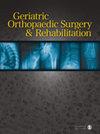基于可穿戴设备的步行计划对老年人步速的影响:系统回顾与元分析》。
IF 1.6
4区 医学
Q4 GERIATRICS & GERONTOLOGY
引用次数: 0
摘要
背景由于步行能力在老龄人口中受到广泛影响,因此研究基于可穿戴设备的步行计划的有效性至关重要。本荟萃分析旨在研究可穿戴设备对老年人步速的影响,并进行亚组分析,评估其对帕金森病(PD)和中风等衰老相关疾病患者的潜在影响。提取并分析了步速、平衡、步幅和步长等结果。研究质量采用 Rob 2 工具进行评估,异质性采用 STATA 16 的 I2 统计法进行检验。干预组的步速有明显改善(加权平均差 (WMD) 0.12;95% CI 0.03 至 0.21)。亚组分析显示了不同的效果:帕金森病亚组和中风亚组有明显改善,而正常衰老组则没有。平衡能力(WMD:1.93;95% CI:0.20 至 3.66)和步长(WMD:8.58;95% CI:3.04 至 14.12)也有改善,但各研究间的异质性为中等(I2 = 63.91%)。结论基于可穿戴设备的步行计划可提高老年人的步速,对患有帕金森病或中风的老年人具有明显优势。这些研究结果表明,此类干预措施可以成为老年护理中个性化治疗策略的重要组成部分,旨在提高老年人的活动能力和日常生活满意度。本文章由计算机程序翻译,如有差异,请以英文原文为准。
Impact of Wearable Device-Based Walking Programs on Gait Speed in Older Adults: A Systematic Review and Meta-Analysis.
Background
As walking abilities are widely affected among the aging population, investigating the effectiveness of wearable device-based walking programs is essential. The intentions of this meta-analysis were to investigate their effects on gait speed among older adults, as well as to include subgroup analysis to evaluate potential effects on individuals with aging-related conditions such as Parkinson's disease (PD) and stroke.
Methods
Systematic retrieval of Pubmed, The Cochrane Library, Embase and Web of Science databases were searched up to February 2024. Outcomes such as gait speed, balance, cadence, and stride length were extracted and analyzed. Study quality was evaluated using the Rob 2 tool and heterogeneity was tested using I2 statistics through STATA 16.
Results
Nine studies with 284 participants were analyzed. The intervention group showed a significant improvement in gait speed (weighted mean difference (WMD) 0.12; 95% CI 0.03 to 0.21). There is a subgroup analysis suggesting differential effects: significant improvements in PD and stroke subgroups, but not in the normal aging group. Balance (WMD: 1.93; 95% CI: 0.20 to 3.66) and stride length (WMD: 8.58; 95% CI: 3.04 to 14.12) were also shown to improve, but the heterogeneity across the studies was moderate (I2 = 63.91%). No significant changes were observed in the Timed Up and Go test, Gait Variability, and Step Width.
Conclusions
Wearable device-based walking programs improve gait speed in older adults, with top notch advantages in the ones tormented by PD or stroke. These findings advocate that such interventions can be a valuable part of individualized treatment strategies in geriatric care, aiming to enhance mobility and usual satisfactory of existence.
求助全文
通过发布文献求助,成功后即可免费获取论文全文。
去求助
来源期刊

Geriatric Orthopaedic Surgery & Rehabilitation
Medicine-Rehabilitation
CiteScore
3.00
自引率
0.00%
发文量
80
审稿时长
9 weeks
期刊介绍:
Geriatric Orthopaedic Surgery & Rehabilitation (GOS) is an open access, peer-reviewed journal that provides clinical information concerning musculoskeletal conditions affecting the aging population. GOS focuses on care of geriatric orthopaedic patients and their subsequent rehabilitation. This journal is a member of the Committee on Publication Ethics (COPE).
 求助内容:
求助内容: 应助结果提醒方式:
应助结果提醒方式:


